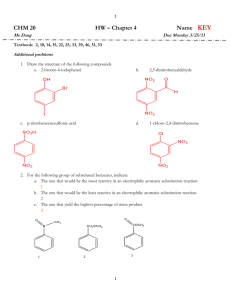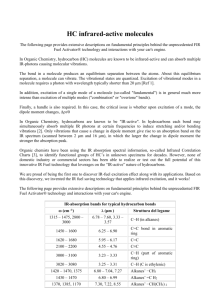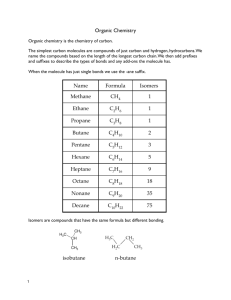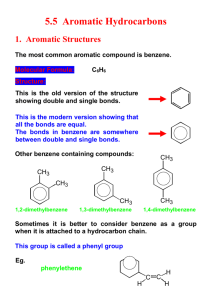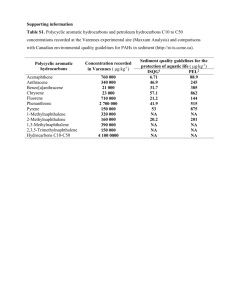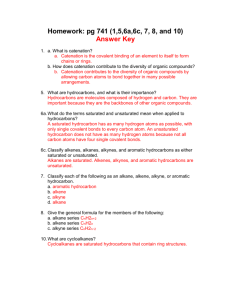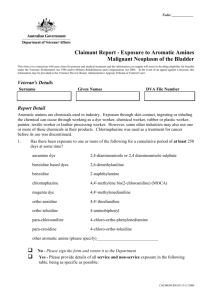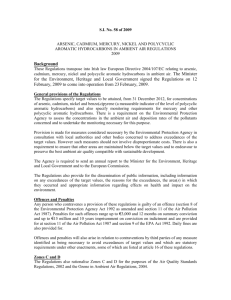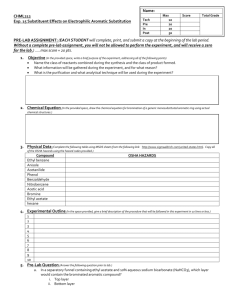1-Nitronaphthalene - IARC Monographs on the Evaluation of
advertisement
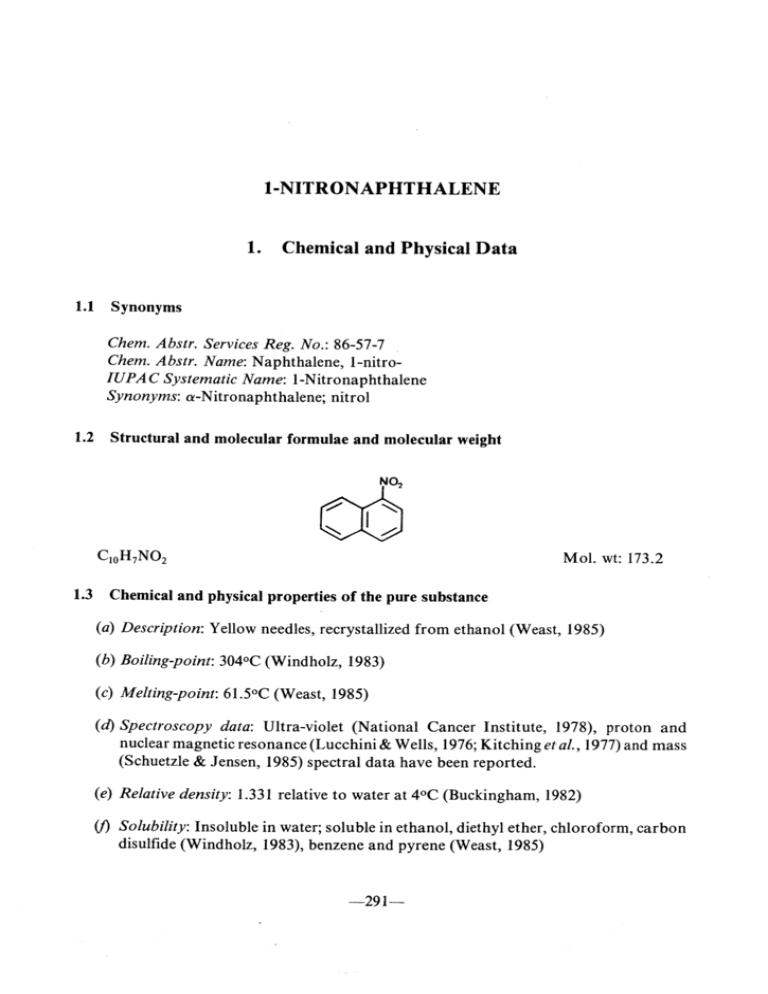
1 -NITRONAPHTHALENE 1. Chemical and Physical Data 1.1 Synonyms Chem. Abstr. Services Reg. No.: 86-57-7 Chem. Abstr. Name: Naphthalene, I-nitroIUPAC Systematic Name: I-Nitronaphthalene Synonyms: a-Nitronaphthalene; nitrol 1.2 Structural and molecular formulae and molecular weight C1oH7NOi M ~ MoL. wt: 173.2 1.3 Chemical and physical properties of the pure substance (a) Description: Yellow needles, recrystallized from ethanol (Weast, 1985) (b) Boilng-point: 304°C (Windholz, 1983) (c) Melting-point: 61.5°C (Weast, 1985) (d) Spectroscopy data: Ultra-violet (National Cancer Institute, 1978), proton and nuclear magne tic resonance (Lucchini & Wells, 1976; Kitching etal., 1977) and mass (Schuetzle & Jensen, 1985) spectral data have been reported. (e) Relative density: 1.331 relative to water at 4°C (Buckingham, 1982) (f Solubilty: Insoluble in water; soluble in ethanol, diethyl ether, chloroform, carbon disulfide (Windholz, 1983), benzene and pyrene (Weast, 1985) -291- 292 IARC MONOGRAPHS VOLUME 46 (g) Flash-point: 164°C (Sax & Lewis, 1987) 1.4 T echnical products and impurities I-Nitronaphthalene is available for research purposes at 99% purity (Aldrich Chemical Co., 1988). It is also available in a certified purity of 99.61 % as a reference material (Belliardo et al., 1988). 2. Production, Use, Occurrence and Analysis 2.1 Production and use (a) Production I-Nitronaphthalene is synthesized by the action of a mixture of nit rie and sulfuric acids on finely ground naphthalene (Sax & Lewis, 1987). Reaction of naphthalene with nitric acid and sulfuric acid in dichloromethane (or another suitable inert solvent) was reported to give a 80% yield of 99.2% purity (Kameo & Hirashima, 1986). There is one producer of this substance in the USA. 1 -Nitronaphthalene is reported on the 1985 Toxic Substances Control Act Chemical Substance lnventory (US Environmental Protection Agency, 1986). (b) Use The uses of 1 -nitronaphthalene include a chemIcal intermediate in the manufacture of dyes (drugs, perfumes, rubber chemicals, tanning agents and pesticides); a fluorescence quencher for mineraI oils (Sax & Lewis, 1987); a 'debloomer' for petroleum oils (Windholz, 1983); a vapour-phase corrosion inhibitor (Foley & Brown, 1979); a wood preservative; and a fungicide (Kasperczak & Lutomski, 1973; Dominik, 1978). A Chinese patent was issued in which (a compound presumed to be) I-nitronaphthalene was proposed as a component at 1-2% in sulfur-free, fragrant fireworks powder (Ying et al., 1986). 2.2 Occurrence (a) Engine exhaust 1 -Nitronaphthalene concentrations of 0.77 mgj kg of particulates were reported in the emissions of a heavy-duty diesel engine run at 100% load and 1200 revolutionsj min; at 75% 0.47 mg/ kg of particulates (Draper, 1986). Nishioka et al. (1982) detected I-nitronaphthalene in the load and 1800 revolutionsj min, the same engine produced concentrations of exhaust emissions of light-duty diesel engines (0.3-0.7 mgjkg), and Liberti et aL. (1984) found this compound in the gas phase of diesel engine exhaust. i -NITRON APHTHALENE 293 (b) Other occurrence Toners for use in photocopy machines have been produced in quantity since the late 1950s and have seen widespread use. 'Long-flow' furnace black was first used in photocopy toners in 1967; its manufacture involved an oxidation whereby some nitration also occurred. Subsequent changes in the production technique reduced the total extractable nitropyrene content from an uncontrolled level" of 5- 100 mg/ kg to below 0.3 mg/ kg (Rosenkranz et al., 1980; Sanders, 1981; Butler et al., 1983), and toners produced from this carbon black since 1980 have not been found to contain detectable levels of mutagenicity or, hence, nitropyrenes (Rosenkranz et aL., 1980; Butler et al., 1983). 1 -Nitronaphthalene has been detected in formerly available commercial carbon blacks (Fitch et al., 1978; Ramdahl & U rdal, 1982). 1 -Nitronaphthalene was detected in urban ambient airborne particulates in St Louis, MO, USA (Ramdahl & Urdal, 1982; Ramdahl et al., 1982), and trace quantities were identified in urban air particulates in Göteborg, Sweden (Brorström-Lundén & Lindskog, 1985). ln a laboratory experiment, I-nitronaphthalene was formed by a gas-phase naphthalene nitration reaction at room temperature and atmospheric pressure with a yield of 18% (Pitts et aL., 1985). It was postulated that significant amounts of 1 -nitronaphthalene result from the night-time gas-phase reaction of naphthalene with nitrogen pentoxide (Pitts, 1987). 1 -Nitronaphthalene was found at 3.5 mg/ kg particulate matter in a hexane/ benzene fraction and at 3. 1 mg/ kg particulate matter in a polycyclic aromatic hydrocarbon fraction of suburban/ industrial ambient air in north-west Philadelphia, P A, USA. It was not found in polar 1 and II fractions (Wise et aL., 1985). A level of2.3 ng/ m3 was found in a night-time sam pIe of ambient air in T orrance, CA, USA, calculated as the sum ofthe concentrations on the filter and three polyurethane foam plugs. A day-time sam pIe contained 3.0 ng/ m3 in approximately equal amounts of 1- and 2-nitronaphthalene; however, this was considered to be a lower limit, since the adsorption capacity of the three polyurethane foam plugs was exceeded (Arey et al., 1987). 2.3 Analysis See the monograph on I-nitropyrene. 294 IARC MONOGRAPHS VOLUME 46 3. Biological Data Relevant to the Evaluation of Carcinogenic Risk to Humans 3.1 Carcinogenicity studies in animais! Oral administration Mouse: Two groups of 50 male and 50 female B6C3FI mice, approximately six weeks old, were fed a basal diet containing 0.06% or 0.12% I-nitronaphthalene ((purity and impurities unspecified) melting-point, 50-53°C) for 78 weeks and observed for a further 18-20 weeks (National Cancer Institute, 1978). Two untreated groups of 50 males and 50 females served as controls. Statistical analyses were based on animaIs that survived at least 52 weeks; more than 80% of the mice survived to 80 weeks. At the end of the experiment, tumours were observed in the respiratory, digestive and endocrine systems in both treated and control animaIs; the incidences did not differ significantly among the four groups. (The Working Group noted that the dose administered was not the maximal tolerated dose.) Rat: Two groups of50 male and 50 female Fischer 344 rats, approximately six weeks old, were fed a basal diet containing 0.05% then 0.06% or 0.18% 1 -nitronaphthalene ((purity and impurities unspecified) melting-point, 50-53°C) for 78 weeks and observed for a further 29-31 weeks (N ational Cancer Institute, 1978). Two untreated groups of 25 females and 25 males and 50 males and 50 females served as controls for the high- and low-dose groups, respectively. Statistical analyses were based on animaIs that survived at least 52 weeks; more than 80% of the rats survived to 80 weeks. At the end of the experiment, tumours were observed in the respiratory, digestive and endocrine systems in both treated and control animaIs; the incidences did not differ significantly among the four groups. (The W orking Group noted that the dose administered was not the maximal tolerated dose and that it was changed during treatment of the low-dose group.) 3.2 Other relevant data (a) Experimental systems (i) Absorption, distribution, excretion and metabolism 1-Naphthylamine (see IARC, 1987) was detected in the urine of male Sprague-Dawley rats administered single intraperitoneal doses of 100 mg/ kg bw 1 -nitronaphthalene (Johnson & Cornish, 1978). Incubation of 1 -nitronaphthalene under anaerobic conditions with a postmitochondrial supernatant from the livers of male Fischer rats resulted in the stoichiometric formation of I-naphthylamine (Poirier & Weisburger, 1974). Under aerobic conditions, a rat liver lThe W orking Group was aware of a study in progress in mice by single subcutaneous injection (lARe, 1988). I-NITRON APHTHALENE 295 metabolic system converted I-nitronaphthalene into dihydrodiol and phenol metabolites (EI-Bayoumy & Hecht, 1982). U nder anaero bic conditions, rabbit liver microsomes catalysed the reduction of I-nitronaphthalene to N-hydroxy- 1 -naphthylamine and 1 -naphthylamine (Sternson, 1975; Tatsumi et aL., 1986). (The W orking Group noted that N-hydroxy- 1 -naphthylamine is carcinogenic to experimental animaIs. See, for example, Garner et al. (1984).) Lung and liver microsomes from male Swiss-Webster mice metabolized I-nitroomal macromolecules. The binding was NADPH- and oxygen-dependent and was inhibited by carbon monoxide, nitrogen and naphthalene to products that bound micros SKF-525A. Little binding was detected with kidney microsomes. Pretreatment of the mice with ß-naphthoflavone enhanced the binding to lung micros omal macromolecules; phenobarbital pretreatment increased the binding to liver microcomes. Incubations were also conducted with lung slices and isolated lung cells. Autoradiographs of the lung slices showed that most of the binding occurred in the epithelial cells of the bronchioles and smaller airways. With the isolated lung cells, there was preferential binding of I-nitronaphthalene to cell populations enriched in Clara cells. ß-Naphthoflavone pretreatment increased the binding of 1 -nitronaphthalene in both the lung slices and isolated lung cells (Rasmussen, 1986). (ii) Toxic effects A single intraperitoneal injection of I-nitronaphthalene (25-200 mg/ kg bw) to male Sprague-Dawley rats resulted in respiratory distress, which generally developed within 24 h (EDso, 60 mg/ kg bw). At necropsy at 24 h, there was diffuse, irregular red mottling on the pleural surface of the lungs and necrosis of nonciliated bronchiolar epithelial ce Ils (Clara cells). Hepatotoxicity was also observed after intraperitoneal injection of 100 mg/kg bw, increasing in severity over 72 h after injection (Johnson et aL., 1984). No toxic effect was observed in mice administered I-nitronaphthalene for 78 weeks at doses up to 0.12% or in rats at doses up to 0.18% in the diet (National Cancer Institute, 1978). (iii) Genetic and related effects The genetic and related effects of nitroarenes and of their metabolites have been reviewed (Rosenkranz & Mermelstein, 1983; Beland et al., 1985; Rosenkranz & Mermelstein, 1985; Tokiwa & Ohnishi, 1986). I-Nitronaphthalene (100 p,g/ dise) preferentially inhibited the growth of DNA repairdeficient Bacilus subtils (Tokiwa et aL., 1987) and induced DNA damage in Salmonella typhimurium (lowest effective dose, 19 p,g/ ml; Nakamura et al., 1987). I-Nitronaphthalene was mutagenic to S. typhimurium, TA1535, TA1538, TA98 and TAlOO (Scribner et al., 1979; EI-Bayoumy et al., 1981; Matsuda, 1981; McCoy et al., 1981; Tokiwa et al., 1981; Löfroth et al., 1984; Vance & Levin, 1984; Dunkel et al., 1985; Mortelmans et al., 1986). It was not mutagenic to TA97 or TA1537 (McCoy et al., 1981; 296 IARC MONOGRAPHS VOLUME 46 Dunkel et aL., 1985; Rosenkranz et al., 1985; Mortelmans et aL., 1986) orto Escherichia coli WP2 uvrA (Dunkel et al., 1985). This compound did not induce sex-linked recessive lethal mutation in DrosophUa melanogaster when administered orally or by injection (Valencia et aL., 1985). I-Nitronaphthalene has been reported (data not given) to induce chromosomal aberrations but not sister chromatid exchange (in Chinese hamster CHO cells) (Shelby & Stasiewicz, 1984). (b) Humans No data were available to the Working Group. 3.3 Epidemiological studies and case reports of carcinogenicity in humans No data were available to the Working Group. 4. Summary of Data Reported and Evaluation 4.1 Exposure data 1 -Nitronaphthalene is used as an intermediate in chemical synthesis. It has been detected in some carbon blacks and in particulate exhaust of diesel engines and has been found at low concentrations in ambient air. 4.2 Experimental data I-Nitronaphthalene was tested for carcinogenicity in mice andrats by oral administra- tion. No carcinogenic effect was observed, but the dose used did not induce toxic effects. 4.3 Human data No data were available to the Working Group. 4.4 Other relevant data N-Hydroxy-I-naphthylamine (which has been shown to induce tumours in experimental animaIs) has been detected asa metaboliteof l-nitronaphthalene in vitro. A single intraperitoneal injection of 1 -nitronaphthalene to rats caused hepatotoxicity and necrosis of the lung. I-Nitronaphthalene induced DNA damage and mutation in bacteria but was not mutagenic to DrosophUa melanogaster. Clara cells of Summary table of genetic and related effects of I-nitronaphthalene karyotes Pro Lower eukaryotes 1 Z .. Plants 1 nsects DRGADGC R G c A D G S '" ~ ln vivo ln vilro M C A T D G S M C A T D G S o Humans AnimaIs Human cells Animal cells D G - Mammalian systems Nonmammalian systems M C DL A D S M C A z~ "" =: '" + _1 + =: ~ t" A, aneuploidy; Ct chromosomal aberrations; Di DNA damage; DL, dominant lethal mutation; G. gene mutation; Il inhibition ofintercellular communication; M, micronuclei; R, mitotic recombination and gene conversion; 5, sisier chromatid exchange: T, cell transformation ln completing ihe loble, tr Z t: the lollowing symbols indicaie ihe consensus 01 the Wocking Group with regard la the results lor each endpoim: point + considered to be positive for the specifie end and level of biological complexity -1 considered to be negative, but only one valid study was available to the W orking Group IV 1. "- IARC MONOGRAPHS VOLUME 46 298 4.5 Evaluation' There is inadequate evidence for the carcinogenicity in experimental animaIs of 1 -nitronaphthalene. No data were available from studies in humans on the carcinogenicity of I-nitronaphthalene. Overall evaluation 1 -Nitronaphthalene is not classifable as to its carcinogenicity to humans (Group 3). 5. References Aldrich Chemical Co. (1988) Aldrich Catalog / H andbook of Fine Chemicals 1988- 1 989, Milwaukee, WI, p. 11 18 Arey, J., Zielinska, B., Atkinson, R. & Winer, A.M. (1987) Polycyc1ic aromatic hydrocarbon and nitroarene concentrations in ambient air during a wintertime high-NOx episode in the Los Angeles basin. Atmos. Environ., 21, 1437-1444 Beland, F.A, Heflch, R.H., Howard, P.C. & Fu, P.P. (1985) The in vitro metabolic activation of nitro polycyc1ic aromatic hydrocarbons. ln: Harvey, R.G., ed., Polycyclic Hydrocarbons and Society, pp. 371-396 - Carcinogenesis (ACS Symposium Series No. 283), Washington DC, American Chemical Belliardo, J.J., Jacob, J. & Lindsey, AS. (1988) The Certifcation of the Purity of Seven Nitropolycyclic Aromatic Compounds, CRM Nos 305,306,307,308,310,311,312, BCR Information Reference Materials (EUR 11254 EN), Brussels, Commission orthe European Communities, p. III Brorström-Lundén, E. & Lindskog, A. (1985) Characterization of organic compounds on airborne partic1es. Environ. int., 11, 183-188 Buckingham, J., ed. (1982) Dictionary of Organic Compounds, 5th ed., New York, Chapman & Hall, p. 4257 (N-01040) Butler, M.A, Evans, D.L., Giammarise, AT., Kiriazides, D.K., Marsh, D., McCoy, E.C., Mermelstein, R., Murphy, C.B. & Rosenkranz, H.S. (1983) Application of Salmonella assay to carbon blacks and toners. ln: Cooke, M. & Dennis, A.J., eds, Polynuclear Aromatic Hydrocarbons, 7th International Symposium, Formation, Metabolism and Measurement, Columbus, OH, Battelle, pp. 225-241 Dominik, J.. (1978) Studies of the stability of insecticidal activity of sorne oily wood preservations 15 years after their application (PoL.). Zesz. ProbL. Postepow Nauk Roln., 209, 135-141 Draper, W.M. (1986) Quantitation of nitro- and dinitropolycyc1ic aromatic hydrocarbons in diesel exhaust particulate mat ter. Chemosphere, 15, 437-447 ¡For definitions of the italicized terms, see Preamble, pp. 25-28. I-NITRON APHTHALENE 299 Dunkel, V.c., Zeiger, E., Brusick, D., McCoy, E., McGregor, D., Mortelmans, K., Rosenkranz, H.S. & Simmon, V.F. (1985) Reproducibility of microbial mutagenicity assays: II. Testing of carcinogens and noncarcinogens in Salmonella typhimurium and Escherichia coli. Environ. Mutagenesis, 7, SuppL 5, 1-248 EI-Bayoumy, K. & Hecht, S.S. (1982) Comparative metabolism in vitro of5-nitroacenaphthene and I-nitronaphthalene. ln: Cooke, W.M., Dennis, A.J. & Fisher, G.L., eds, Polynuclear Aromatic Hydrocarbons, Sixth International Symposium, Physical and Biological Chemistry, Columbus, OH, Battelle, pp. 263-273 EI-Bayoumy, K., Lavoie, E.J., Hecht, S.S., Fow, E.A. & Hoffmann, D. (1981)The influenceofmethyl substitution on the mutagenicity of nitronaphthalenes and nitrobiphenyls. Mutat. Res., 81, 143-153 Fitch, W.L., Everhart, E.T. & Smith, O.H. (1978) Characterization of carbon black adsorbates and artifacts formed during extraction. AnaL. Chem., 50, 2122-2126 Foley, R.T. & Brown, RF. (1979) Corrosion and corrosion inhibitors. ln: Mark, H.F., Othmer, D.F., Overberger, c.G., Seaborg, G.T. & Grayson, M., eds, Kirk-Othmer Encyclopedia ofChemical Technology, 3rd ed., VoL. 11, New York, John Wiley & Sons, pp. 113-142 Garner, R.C., Martin, C.N. & Clayson, D.R (1984) Carcinogenic aromatic amines and related compounds. ln: Sear1.e, C.E., ed, Chemical Carcinogens, 2nd ed., VoL. 1 (A CS Monograph 182), Washington DC, American Chemical Society, pp. 175-276 IARC (1987) IARC M onographs on the Evaluation of Carcinogenic Risks toHumans, Supplement 7, Overall Evaluations of Carcinogenicity: An Updating of IARC Monographs Volumes 1 to 42, Lyon, pp. 260-261 IARC (1988) Information Bulletin on the Survey of Chemicals Being Testedfor Carcinogenicity, No. 13, Lyon, p. 20 Johnson, D.E. & Cornish, H.H. (1978) Metabolic conversion of 1- and 2-nitronaphthalene to 1- and 2-naphthylamine in the rat. Toxicol. appl. Pharmacol., 46, 549-553 Johnson, D.E., Riley, M.G.!. & Cornish, H.H. (1984) Acute target organ toxicity of I-nitronaphthalene in the rat. J. appl. Toxicol., 4, 253-257 Kameo, T. & Hirashima, T. (1986) Mononitration of naphthalene with nItric acid in inert solvents (Jpn.). Chem. Express, 1, 371-374 (Chem. Abstr., 106, 119419r) Kasperczak, R & Lutomski, K. (1973) Fungicidal properties of by-products formed during the production of dinitrophenol and a-nitronaphthalene (PoL). Rocz. Akad. Roln. Poznaniu,62, 87-100 Kitching, W., Bullpitt, M., Gartshore, D., Adcock, W., Khor, T.O., Doddrell, D. & Rae, 1.0. (1977) Carbon-13 nuc1ear magne tic resonance examination of naphthalene derivatives. Assignments and analysis of substituent chemical shifts. J. org. Chem., 42, 2411-2418 Liberti, A., Cieeioli, P., Cecinato, A., Branealeoni, E. & Di Pal0, C. (1984) Determination of nitrated-polyaromatie hydroearbons (nitro- P AHs) in environmental samples by high resolution chromatographie teehniq ues. J. high Resolut. Chromatogr. Chromatogr. Commun., 7,389-397 o Löfroth, G., ToftglÎrd, R., Nilsson, L., Agurell, E. & Gustafsson, J.-A. (1984) Short-term bioassays of nitro derivatives of benzo(a)pyrene and perylene. Carcinogenesis, 5, 925-930 Lucehini, V. & Wells, P.R. (1976) Proton magnetic resonance spectra of monosubstituted .naphthalenes. Org. magn. Resonance, 8, 137-140 Matsuda, A. (1981) Studies on the mutagenicity of nitro-aromatic compounds in the environment (Jpn.). Gifu Daigaku Igakuba Kiyo, 29, 278-296 300 IARC MONOGRAPHS VOLUME 46 McCay, E.C., Rosenkranz, E.J., Petrullo, L.A., Rosenkranz, H.S. & Mermelstein, R. (1981) Structural basis of the mutagenicity in bacteria of nitrated naphthalene and derivatives. Environ. Mutagenesis, 3,499-511 Mortelmans, K., Haworth, S., Lawlor, T., Speck, W., Tainer, B. & Zeiger, E. (1986) Salmonella mutagenicity tests: II. Results from the testing of270 chemicals. Environ. Mutagenesis, 8, Suppl. 7, 1- 11 9 Nakamura, S.-l., Oda, Y., Shimada, T., Oki, 1. & Sugimoto, K. (1987) SOS-inducing activity of chemical carcinogens and mutagens in Salmonella typhimurium TAI535/pSKI002: examination with 151 chemicals. Mutat. Res., 192,239-246 National Cancer Institute (1978) Bioassay oll-Nilronaphthalenelor Possible Carcinogenicily (NCICG-TR-64)(DHEW Publication No. NIH78-1314), Bethesda, MD, US DepartmentofHealth, Education, and Welfare Nishioka, M.G., Petersen, B.A. & Lewtas, J. (1982) Comparison of nitro-aromatic content and direct-acting mutagenicity of diesel emissions. ln: Cooke, M., Dennis, A.J. & Fisher, G.L., Polynuclear Aromatic Hydrocarbons, Sixth International Symposium, Physical and Biological Chemistry, Columbus, OH, Battelle, pp. 603-613 Pitts, J.N., Jr (1987) Nitration of gaseous polycyc1ic aromatic hydrocarbons in simulated and ambient urban ætmospheres: a source of mutagenic nitroarenes. Atmos. Environ., 21,2531-2547 Pitts, J.N., Jr, Atkinson, R., Sweetman, J.A. & Zielinska, B. (1985) The gas-phase reactions of naphthalene with N20s to form nitronaphthalenes. Atmos. Environ., 19, 701-705 Poirier, L.A. & Weisburger, J.H. (1974) EnzymIc reduction of carcinogenic aromatic nitro compounds by rat and mouse liver fractions. Biochem. Pharmacol., 23,661-669 Ramdahl, T. & U rdal, K. (1982) Determination of nitrated polycyc1ic aromatic hydrocarbons by fused silica capilary gas chromatography / negative ion chemIcal ionization mass spectrometry. Anal. Chem., 54, 2256-2260 Ramdahl, T., Becher, G. & BjØrseth, A. (1982) Nitrated polycyc1icaromatic hydrocarbons in urban air particulates. Environ. Sei. Technol., 16, 861-865 Rasmussen, R.E. (1986) Metabolism and macromolecular binding of I-nitronaphthalene in the mouse. Toxicology, 41, 233-247 Rosenkranz, H.S. & Mermelstein, R. (1983) Mutagenicity and genotoxicity of nitroarenes: all nitro-containing chemicals were not created equal. Mutat. Res., 114,217-267 Rosenkranz, H.S. & Mermelstein, R. (1985) The genotoxicity, metabolism and carcinogenicity of nitrated polycyc1ic aromatic hydrocarbons. J. environ. Sci. Health, C3, 221-272 Rosenkranz, H.S., McCoy, E.C., Sanders, D.R., Butler, M., Kiriazides, D.K. & Mermelstein, R. (1980) Nitropyrenes: isolation, identification and reduction of mutagenic impurities in carbon black and toners. Science, 209, 1039-1043 Rosenkranz, H.S., McCoy, E.C., Frierson, M. & Klopman, G. (1985) The role ofDNA sequence and structure of the electrophile on the mutagenicity of nitroarenes and arylamine derivatives. Environ. Mutagenesis, 7, 645-653 Sanders, D.R. (1981) Nitropyrenes: the isolation of trace mutagenic impurities from the toluene extract of an aftertreated carbon black. ln: Cooke, M. & Dennis, A.J., eds, Polynuclear Aromatic Hydrocarbons, 5th International Symposium, Chemical Analysis and Biological Fate, Columbus, OH, Battelle, pp. 145-158 1-NITRON APHTHALENE 301 Sax, N.l. & Lewis, R.J., eds (1987) Hawley's Condensed Chemical Dictionary, llth ed., New York, Van Nostrand Reinhold, p. 735 Schuetzle, D. & Jensen, T.E. (1985) Analysis of nitrated polycyclic aromatic hydrocarbons (nitroP AH) by mass spectrometry. ln: White, C. M., ed., Nitrated Polycyclic Aromatic Hydrocarbons, Heidelberg, A., Hüthig Verlag, pp. 121-167 Scribner, J.D., Fisk, S.R. & Scribner, N.K. (1979) Mechanisms of action of carcinogenic aromatic amines: an investigation using mutagenesis in bacteria. Chem.-biol. Interactions, 26, 11-25 Shelby, M.D. & Stasiewicz, S. (1984) Chemicals showing no evidence of carcinogenicity in long-term, two-species rodent studies: the need for short-term test data. Environ. Mutagenesis, 6, 871-878 Sternson, L.A. (1975) Detection of arylhydroxylamines as intermediates in the metabolic reduction of nitro compounds. Experientia, 31,268-270 Tatsumi, K., Kitamura, S. & Narai, N. (1986) Reductive metabolism of aromatic nitro compounds including carcinogens by rab bit liver preparations. Cancer Res., 46, 1089-1093 Tokiwa, H. & Ohnishi, Y. (1986) M utagenicity and carcinogenicity of nitroarenes and their sources in the environment. CRC crit. Rev. Toxicol., 17,23-69 Tokiwa, H., Nakagawa, R. & Ohnishi, Y. (1981) Mutagenic assay of aromatic nitro compounds with Salmonella typhimurium. Mutat. Res., 91, 321-325 Tokiwa, H., Nakagawa, R., Horikawa, K. & Ohkubo, A. (1987) The nature of the mutagenicity and carcinogenicity of nitrated, aromatic compounds in the environment. Environ. Health Perspect., 73, 191-199 US Environmental Protection Agency (1986) Toxic Substances Control Act Chemical Substance Inventory, 1985 ed., VoL. ill, Substance Name Index (EPA-560/7-85-002c), Washington DC, Office of Toxic Substances Valencia, R., Mason, J. M., W oodruff, R.C. & Zimmering, S. (1985) Chemical mutagenesis testing in Drosophila. Iii. Results of 48 coded compounds tested for the National Toxicology Program. Environ. Mutagenesis, 7, 325-348 Vance, W.A. & Levin, D.E. (1984) Structural features of nitroaromatics that determine mutagenic activity in Salmonella typhimurium. Environ. Mutagenesis, 6, 797-811 Weast, R.C. (1985) CRC Handbook ofChemistry and Physics, 66th ed., Boca Raton, FL, CRe Press, p. C-361 Windholz, M., ed. (1983) The Merck Index, 10th ed., Rahway, NJ, Merck & Co., p. 949 Wise, S.A., Chesler, S.N., Hilpert, L.R., May, W:E., Rebbert, R.E., Vogt, C.R., Nishioka, M.G., Austin, A. & Lewtas, J. (1985) Quantification of polycyclic aromatic hydrocarbons and nitrosubstituted polycyclic aromatic hydrocarbons and mutagenicity testing for the characterization of ambient air particulate matter. Environ. int., 11, 147-160 Ying, B., Zhong, Z., Liu, J., Li, J. & Xian, P. (1986) Sulfur-free Fragrant Fireworks Powder. Patent issued 10 April 1986, CN 85,101,596 (F42B4/04) (Chem. Abstr., 106, 122513x)
